The importance of doing an exercise with the right form can’t be stressed enough. Not only by doing an exercise with the right form and right way, you can get better results, but the chances of getting injured are significantly decreased as well. Often, in an effort to do more repetitions or lift more weight than usually could be managed, people tend to cheat on the form of the exercise. The result is that they can lift more weight or could do more repetitions which soothes and nurtures their fragile egos.
But, doing so has several negative short term and long term effects. The short term effect being that you are not working your targeted muscles enough and can’t rightly gauge the progress you have made. Whereas, the long term effect is that you are putting unnatural stress on your joints and muscles, due to which you can suffer crippling injuries.
With the right form, you won’t be able to lift as much weight as you could by cheating. But, tell me what is more important – a minor ego boost or proper results? So, if the former is your answer, then it would be better that you stop reading now because this article would only hammer your fragile ego. And, if the answer is latter, then my good man, this article is just for you. Read on.
-
Barbell Bent Over Rows
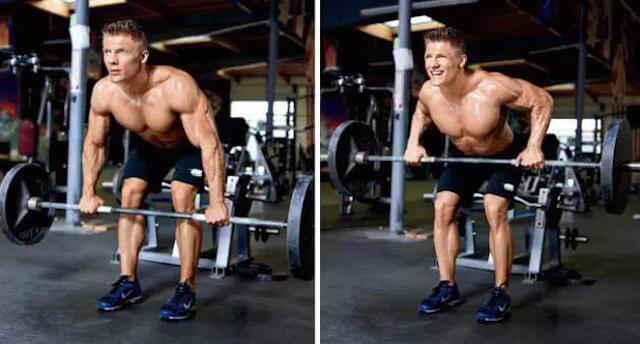
This is probably one of the best free weight exercises for your back. It hits your upper back hard and also engages your lower back to maintain the balance. To lesser extent, it also works your biceps and hits your pectoral muscles (chest). However, due to balancing issues, barbell bent over rows can be bit difficult and complex to master. Here, are the common mistakes that people often do while doing barbell bent over row.
- Standing too upright
- Rounding your back or flexing your spine
- Going on the tip toes.
- Tilting your head back.
- And, swinging and thrusting your hips in to gain leverage.
If you are making any of the above mentioned mistakes, better stop it and learn the right form, which we would be discussing shortly. These mistakes especially flexing spine and getting on tip toes is very bad for your back.
Your feet should be wide apart than they are while doing deadlifts, but narrower than they are while doing squats. Please note this stance and all the steps described below are for medium grip barbell bent over rows. If you are going to use a narrow grip, then your stance should be narrower. Whereas, if the grip is wider, then keep your feet more wide.
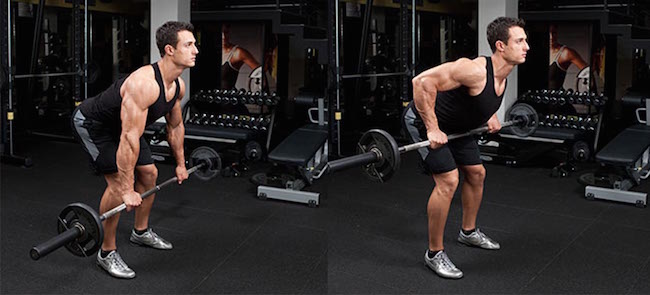
The grip should be wide apart from the one for deadlifts, but narrower than you have for bench press. Having the grip wider would make the weight easier to move and also places more stress on the upper back. The wrists should be straight and bar should be held in full grip. The wrists should be locked and should form a straight line to your elbows. While doing the exercise, don’t let your wrists bend back as it would hurt. And, if they are bending back, then your grip is loose.
Your knees should be bent slightly, bring your torso forward, by bending at the waist. Your back should be straight. Now, keep your torso stationary and lift the barbell towards you. The elbows should be kept close to the body and only forearms should be used to hold weight. When the barbell is touching your body or is near to it, squeeze the back muscles and hold for a moment. And, then lower it down, slowly.
-
Overhead Press
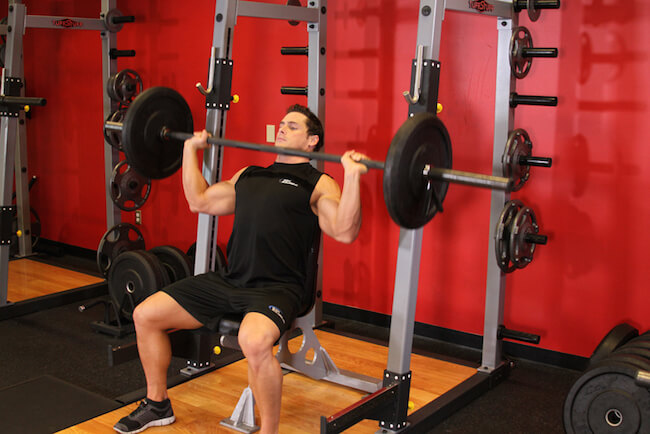
Nothing sculpts your shoulder like the overhead press. When done with the right form and in the right way, the overhead press can help you develop the much cavorted cannonball shoulders. No other shoulder exercise hits all the shoulder muscles at the same time as overhead press. The only problem is that people tend to get it wrong or are plain intimidated by it.
Here are the most common mistakes that people often make when doing the overhead barbell press.
- Gripping the bar too wide
- Lack of core tightness or glute tightness, in case you are doing them while standing.
- Bending too far back and converting them into incline press.
- Pressing in front of the body.
- Not using the full range of motion.
- Not controlling the descent.
Depending on which mistake you are making, the wrong form could lead to variety of problems ranging from lack of muscle development to chronic shoulder problems. So, it goes without saying that the form should be right. Absolutely, right. And, here is a guide to ensure that you do it right. For the sake of convenience and to get the form right, use the squat rack. In the instructions listed below, we will be using the same.
In the squat rack, sit on a bench with a back support. Place a barbell in the rack at a height that is just above your head. Now, grab the bar firmly just outside your shoulder. The exact width of the grip depends on how wide your shoulders are. For convenience and optimal grip, ensure that your forearms are vertical to the floor. Never go for the wider bench press grip. For one, it will make it harder to press the weight up and will make your elbow flare out, which is never good for your shoulders.
Now with the proper grip, lift the barbell up over your head by locking your arms. Hold it at the same position, slightly in front of your head. This is the starting point. Lower the bar down to the shoulders as you inhale. Hold it on your muscles, in front of your throat. Raise your chest by creating an arch and press your triceps against lats, to ensure that the forearms are in a vertical position. Lift your chest slightly as you press the bar off your shoulders. Because of this, your upper back will arch, but ensure that your lower back is in neutral position. Now, lift the bar back to the starting position as you exhale.
-
Bicep Curls, Barbell and Dumbbell
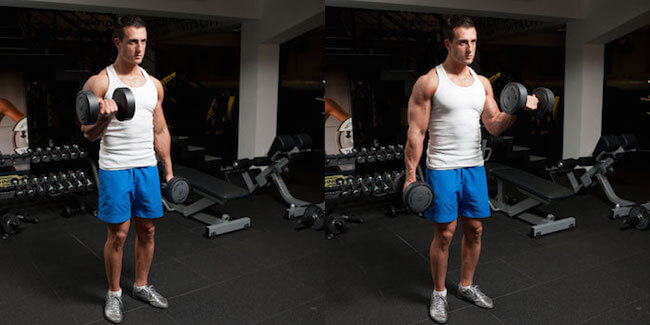
The bicep curls is arguably the most popular and executed exercise in the whole world. No matter which country you are in, and no matter what age group and fitness group you are training with, you will always see someone curling them in front of the mirror and once in a while, taking admiring and satisfying glances of their bulging guns. Despite, bicep curl’s popularity and well use, it is often seen that people tend to do it with a completely wrong form.
Once again, the most common reason for a bad form is that most people driven by their ego to lift more than they have the strength to, cheat to curl heavier weight by swinging their hips around like a cabaret dancer. These are the other mistakes people tend to make while doing bicep curls.
- Using the shoulders to swing the weight up or leaning back to get a leverage
- Not bringing the weight all the way down until the elbows are locked out
- Letting the weights drop down too quickly and using the momentum to swing it up
- Curling wrist inwards or upwards
- Allowing elbows to flare out
Though, the wrong form in this exercise can’t cause as serious injury as other exercises in this list do, but still there is a danger of hurting your wrists. Another result of wrong form is that you won’t hit your bicep muscles hard enough. As a result, your biceps will remain as they are, small.
The grip shouldn’t be too wide or too narrow, it should be comfortable enough. Now, before swinging it up, tighten your core and brace your glutes and focus only on using the biceps to pull weight up. Whether you are going to do barbell or dumbbell curls, keep your wrists straight or keep them bit loose, trailing behind. By doing this, you will reduce stress on the forearms to great extent and will minimize strain on wrists.
If you are doing the alternative dumbbell curls, start with arms with your side and palms facing your legs. This is more convenient as it serves as a comfortable starting place and also allows you to engage the biceps muscles better by adding the twisting motion in middle of the swing. As soon as you clear the leg, turn your wrists upwards and squeeze hard at the top of the motion. Now, slowly lower the weight until your arm is fully extended.
-
Sit-ups

Sit-ups is arguably one of the simplest exercises. But, that doesn’t mean people won’t get it wrong. Due to its ability to sculpt the mid-section and to melt fat on your gut, it is one of the most done exercises.
Of course, the inability to get the form wrong won’t cause a serious injury. However, by doing the sit-ups wrong, you run the danger of invoking lower back problems. Sit-ups done in the right way will help you achieve your fitness goals faster. So, keep your eye out on these mistakes, while doing sit-ups.
- Using hands to use leverage.
- Placing the hands behind the neck and pulling them with the motion.
- Pulling the head too far forward.
- Tucking chin into the chest.
- Going too fast and using the momentum to just swing to and fro.
- Rounding the lower back.
- Not breathing throughout the motion.
Lie on your back, bend your knees with feet placed flat on the floor or mat. Ensure that your heels are placed about one to one and half feet from your tailbone. Now, place your fingertips lightly behind your head or cross your arms on your chest. Exhale and tighten your abs. Squeeze your shoulder blades together and curl up towards your bent knees. Make sure you are not pulling your head forward with your hands. Keep it straight in line with your spine and tilt your head forward as you come up.
Your feet and tailbone should be flat against the floor throughout the exercise. Keep moving towards your thighs, until you are in a sitting position. Pause for a count of two, inhale and start lowering yourself, until your back is flat against the floor. Keep your abdominal muscles tight during the downward phase of the movement.
-
Hanging Leg Raises
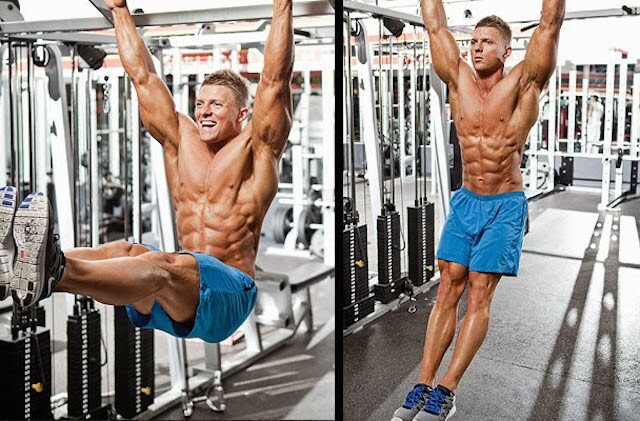
This is another great core exercise that can yield great results if done with the right way. It pre-dominantly hits the lower abdominals and also engages the oblique muscles. A bit more challenging than the sit-ups, the hanging leg raises hits your abs hard. And, go long way in defining the mid-section.
As it is bit difficult to do and nearly impossible for the beginners, you won’t see many doing it around. However, when they are done, these are the common mistakes, people often tend to make.
- Letting the legs flop around like a drowning novice.
- Lifting the legs or knees half way up.
- Excessive swinging of the legs.
Though, swinging your legs around would give you a bit of a cardio workout, but as you are targeting your abs with it, so, it is better to stick with your objective. The beginners should start with lying leg raises. This will make your core strong enough. Also, work on your grip, so that you could hold the bar long enough to complete the exercise.
While doing the exercise, the focus should be on keeping the legs straight and lifting them as high as possible. Also, ensure that by engaging the hip flexors, you can pull your knees close to your chest or the toes near the bar. Now, lower your legs slowly and under control.
